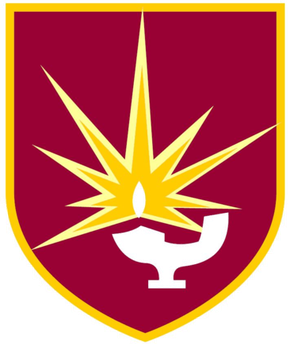
Tunbridge Wells Grammar School for Boys (TWGSB) is a grammar school in Royal Tunbridge Wells, Kent, England.

Seven Kings School, previously Seven Kings High School, is a co-educational comprehensive primary and secondary school located in Ilford in the London Borough of Redbridge, England. It caters for pupils aged 4–18 years old. Seven Kings School has separate primary and secondary classroom blocks located within a short walking distance from each other. The school participates in, and has won awards from, notable UK schemes including those such as the Jack Petchey Award. It is a National Teaching School. Seven Kings has been a pioneer in its inclusion policies which integrate pupils with special needs and disabilities.
Lincolnshire is one of the few counties within the UK that still uses the eleven-plus to decide who may attend grammar school, in common with Buckinghamshire and Kent.

Northallerton School is a coeducational secondary school and sixth form located in Northallerton, North Yorkshire, England. The school is located over two sites on Brompton Road and Grammar School Lane.

Chatham Grammar School for Girls ("CGSG") is a girls grammar school with academy status and a mixed sixth form. In September 2017 it became a member school of the University of Kent Academies Trust (UKAT), joined with another secondary school, Brompton Academy.
Since 2019 it has described itself as Chatham Grammar School on its website and signage, reflecting the presence of boys on the sixth form roll.

Boston High School, also known as Boston High School for Girls, is a selective grammar school and sixth form college for girls aged 11 to 18 in Boston, Lincolnshire, England. The school's sixth form has been coeducational since 1992.

The Hathershaw College is a coeducational, Secondary Academy for 11- to 16-year-olds in Oldham, Greater Manchester, England.

Saint Marylebone School is a secondary school for girls in Marylebone, London. It specialises in Performing Arts, General Arts, Maths & Computing. In the sixth form, boys can attend as well. The school then became a converter academy, having previously been judged as "outstanding in every respect" by Ofsted.

Roundhay School is a mixed, all-through and sixth form community school in Roundhay, Leeds, West Yorkshire, England. In 2020, the school received a World Class Schools Quality Mark, which requires an 'Outstanding' Ofsted assessment as well as further assessments.
King Edward VI High School is a coeducational secondary school and sixth form located in the Highfields area of Stafford, England. The school's sixth form forms part of the Stafford Collegiate. It is a non-selective state school admitting boys and girls from ages 11–18. The school was formed in 1977 following the amalgamation of King Edward VI Boys’ Grammar School and Stafford Girls’ High School.

Fort Pitt Grammar School is a selective girls' grammar school with academy status in Chatham, Kent. Built on Fort Pitt Hill on the site of a Napoleonic era fort, it is situated next to the former Rochester campus of the University for the Creative Arts, which closed in 2023.
Bournville School is an all-through school and primary school with academy status, for students aged 4–16, in Bournville, Birmingham in the United Kingdom. The school has around 850 pupils currently on the roll, including a primary provision of around 150 students. The school became an Academy School on 1 November 2014 under the sponsorship of The Fairfax Multi Academy Trust (FMAT). Fairfax Academy is also in the same MAT.
The Norton Knatchbull School is a grammar school with academy status for boys located in Ashford, Kent, England. Girls are accepted into the Sixth Form. As of 2017, the school serves more than one thousand pupils aged 11 to 18.

The Canterbury Academy is a co-educational 11-19 academy school in Canterbury, Kent, England. It is a specialist Sports College and 15% of its 1081 pupils are selected on musical aptitude. The school was founded as a non-selective secondary modern foundation school before gaining academy status in 2010.
The Elizabethan Academy is a secondary school with academy status located in the Nottinghamshire market town of Retford, England. It is situated to the north of Retford town centre, to the east of the A638, on the side of the River Idle once known as West Retford. The academy has specialist status in Science and Mathematics.

Valentines High School is a coeducational secondary school and sixth form located in the Ilford area of the London Borough of Redbridge, England. It has approximately 1300 pupils and 93 teachers. Valentines has been a teaching school since 2011, and is a member of the Leading Edge partnership programme. In 2006, it was designated as a specialist school for technology and had technology college status.

Highsted Grammar School is a state-funded selective secondary school for girls in Sittingbourne, Kent.

Knole Academy is a secondary school in Sevenoaks, Kent, England, with a grammar band. Knole opened in September 2010 as a result of the amalgamation of the Wildernesse secondary school in Sevenoaks, Kent and Bradbourne School.
The Spires Academy is a non-selective secondary school for pupils aged 11–16 in Canterbury, Kent. There is a sixth form. The school has dual specialist status in business and enterprise, and in visual, creative and performing arts. Spires is independently governed, but funded by the sponsors and the Department for Children, Schools and Families. As a non-selective school the school does not insist on prospective pupils passing the eleven-plus examination for entry, and it is free to attend. The Academy is subject, like other schools, to regular inspections, but is managed by an ‘Academy Trust’ called E21C, rather than a local education authority. According to Ofsted inspectors, boys do worse at maths at the school, and generally the school needs to improve (academically).

St John's Catholic Comprehensive School is a coeducational Roman Catholic secondary school and sixth form, located in Gravesend in the English county of Kent.















